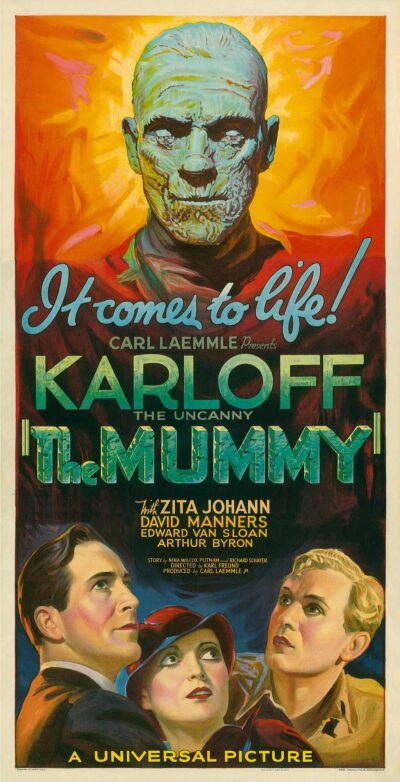 A rarity: a golden age horror film that almost holds up. Capitalizing on the Egyptology craze fueled by the 1922 opening of King Tutankhamen’s tomb, THE MUMMY (1932) wasn’t the first filmic treatment of the horrors of ancient Egyptian corpses (the 1901 short THE HAUNTED CURIOSITY SHOP, about a decaying mummy, beat it to the punch), but it’s become the most iconic, with a presentation of a mummy, as a hulking fellow wrapped in bandages, that has endured despite the fact that it’s factually inaccurate. It starred Boris Karloff (1887-1969), one of the genre’s foremost icons, and was directed by Karl Freund (1890-1969), who as cinematographer of films like THE GOLEM (1920) and DRACULA (1931), and director of MAD LOVE (1935), served as another key architect of 20th Century horror cinema.
A rarity: a golden age horror film that almost holds up. Capitalizing on the Egyptology craze fueled by the 1922 opening of King Tutankhamen’s tomb, THE MUMMY (1932) wasn’t the first filmic treatment of the horrors of ancient Egyptian corpses (the 1901 short THE HAUNTED CURIOSITY SHOP, about a decaying mummy, beat it to the punch), but it’s become the most iconic, with a presentation of a mummy, as a hulking fellow wrapped in bandages, that has endured despite the fact that it’s factually inaccurate. It starred Boris Karloff (1887-1969), one of the genre’s foremost icons, and was directed by Karl Freund (1890-1969), who as cinematographer of films like THE GOLEM (1920) and DRACULA (1931), and director of MAD LOVE (1935), served as another key architect of 20th Century horror cinema.
Other important names associated with THE MUMMY include Universal horror screenwriter extraordinaire John L. Balderston (1889-1954), who contributed to the scripts of DRACULA (1931), FRANKENSTEIN (1931), THE BRIDE OF FRANKENSTEIN (1935) and DRACULA’S DAUGHTER (1936), and actress Zita Johann (1904-1993), who makes quite an impression, and famously disclosed some none-too-savory details about THE MUMMY’S production.
The film’s legacy is a long and frankly not-very-inspiring one. It spawned the quickie 1940s-era sequels THE MUMMY’S HAND (1940), THE MUMMY’S TOMB (1942), THE MUMMY’S GHOST (1944) and THE MUMMY’S CURSE (1944), as well as ABBOTT AND COSTELLO MEET THE MUMMY (1955) and a handful of remakes: the Hindi KALKOOT (1935), the hammer made 1959 variant and the glossy in-name-only Hollywood versions from 1999 and 2017.
The original, and best, MUMMY opens with the corpse of Imhotep (Karloff), an ancient Egyptian prince who due to his sins was subjected to mummification while he was still alive, discovered by an archeological expedition. One of the archeologists (Bramwell Fletcher) uncovers the ancient Scroll of Thoth, from which he reads aloud–and in so doing resurrects the 3,700 year old Imhotep. The latter steals the scroll and, eleven years later, turns up in the guise of an ominous individual named Ardath Bay (Karloff) at an Egyptian camp being overseen by Frank Whemple (David Manners), who’s in search of the tomb of Princess Anck-es-en-Amon, Imhotep’s lover.
Enter the British noblewoman Helen Grosvenor (Johann). Frank is in love with Helen, but she’s the reincarnation of the Princess, and Ardath, ensconced in the museum in which his remains were interred, uses his mesmeric powers to draw her into his orbit. He exhibits scenes from their past incarnations in a pool that transforms into a large TV screen (a portion that underwent extensive postproduction cuts, with stills being the sole reminder of what once was), his ultimate goal being to kill Helen and turn her into a living mummy.
THE MUMMY was met with mixed reviews and muted box office, and that initial non-reaction wasn’t entirely unjustified. It’s too talky and stage-bound by far, and too focused on the very bland David Manners as Frank. Karloff, with his highly soulful—and dramatically lit—eyes, is far more compelling, as is Zita Johann, who spends the final third in a seriously skimpy outfit (Freund reportedly wanted her to go topless).
The camerawork by Charles Stumar, make-up by Jack P. Pierce (who subjected Karloff’s face to a reported eight hours of rubber cement and paint each morning) and art direction by Willy Pogany are all superlative. Conjured is an atmosphere of Lovecraftian evil, as in a highly minimalistic early scene depicting the mummy’s rebirth that, despite this being the first Universal Pictures horror film to contain music, takes place in eerie silence.
Vital Statistics
THE MUMMY
Universal Pictures
Director: Karl Freund
Producer: Carl Laemmle Jr.
Screenplay: John L. Balderston
Cinematography: Charles Stumar
Editing: Milton Carruth
Cast: Boris Karloff, Zita Johann, David Manners, Arthur Byron, Edward Van Sloan, Bramwell Fletcher, Noble Johnson, Kathryn Byron, Leonard Mudie, James Crane, Henry Victor
